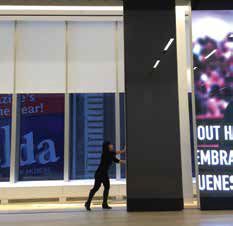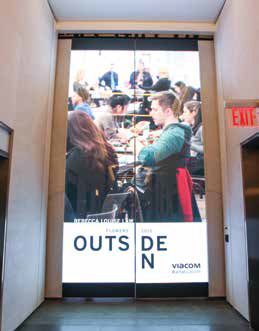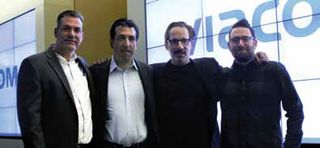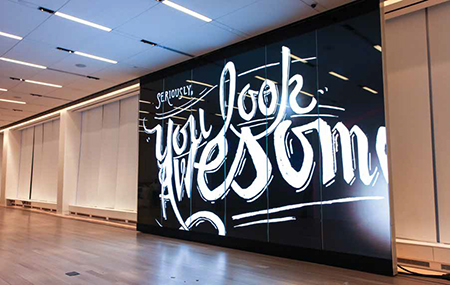For more than 100 years, Times Square has been known for its bright lights and iconic New Year’s Eve Ball. Shining even brighter today, LED displays cover nearly every available façade used to advertise products, promote Broadway productions, and engage the more than 300,000 pedestrians and another 115,000 people traveling through by car or bus, every day.
In 2012, Viacom, the entertainment company that owns, among others, the brands MTV, VH1, BET, Nickelodeon, Comedy Central, TV Land, Spike, and Paramount Pictures, renewed the lease at their New York City headquarters located at 1515 Broadway, between 44th and 45th Streets.
While blazing in LED glory on the outside, the main lobby of the media giant responsible for creating some of the most distinctive brands in the media business lacked the branding, and “wow factor” that the company was seeking.
ENVISIONING EXPERIENTIAL BRANDING
“The goal of the Viacom project team was to provide eye-popping technology that would create a unique media experience for employees and visitors alike, combining channel branding with the artistic talents of Viacom’s industry leading creative teams,” said Mike Bivona, vice president of Broadcast and Production Engineering for Viacom Media Networks. To drive the architectural vision, Viacom’s Core Services team engaged with Studios Architecture to design the second-floor lobby entrance and architectural design firm, Gensler to transform a space once used as a tape library into a much needed event space. This became known as the “White Box.”



The White Box event space is 140 feet wide by 50 feet deep. Six 4-feet-wide by 15.61-foot tall LED Blades hang from a 190-feet, custom designed track, which runs along the 140-feet wall facing the entrance, and makes a 90-degree turn onto the 50-foot wall at the right of the room. Each Blade can be manually moved to any location along the track, and in any configuration; e.g., each spaced individually along the wall, two-by-two, one-by-two, or all six together creating a 16:9 aspect ratio. All images used by permission of Viacom International Inc. Images on displays are copyright ©Viacom International Inc.
In keeping with that of a media company, the architectural vision called for displays throughout the spaces, but with content that needed to transcend far beyond basic digital signage. “To fulfill this vision the project required a blend of technical expertise, ranging from traditional AV to television production,” said Bivona. At the end of 2013, while still at the conceptual phase, Viacom tapped Bivona to lead the technology portion of the project. “Without a doubt, expectations around the creative and visual impact were sky high,” Bivona explained. “Our challenge was to balance those expectations with technology that fit within the architectural vision and could be sustainable on a day-to-day basis.”
1515 Broadway is not only Viacom’s corporate headquarters it is also the creative and technical hub for many of its brand activities. This location is home to some of Viacom’s live production studios, as well as many content creation workgroups that would be contributing content to this new experimental environment, all supported by Viacom’s Media & Technologies Services (MTS) group. “It took multiple technologies teams working together, lead by MTS’s Production Technologies group, to make this project a success. Going into the process we also understood the need for external expertise to help deliver this cutting edge experience, so we decided to bring in a media design firm and AV system integrator,” said Bivona.
This led to introductions to audiovisual design firm McCann Systems, and architecture, planning, and design firm, Rockwell Group, both instrumental in creating innovative digital installations. “The LAB at Rockwell provided the creative, architectural vision, and McCann had the expertise to bring that vision to reality,” said Viacom senior director of Production Technologies, Bill Anchelowitz. Now Viacom had the team to execute.
CONTENT VISION, PLANNING AND COLLABORATION

1515 Broadway comprises two mirror-image entrances: one on 44th Street, and one on 45th Street and Broadway that lead up to the second-floor lobby of Viacom. Passing through the turnstile, and after the security desk, employees and guests are greeted by two massive video walls on the outside of elevator bank walls, made up of 16, 55-inch, LG Super Narrow Bezel Video Wall panels set up in a 4 x 4, landscape configuration, creating a combined 16:9 aspect ratio. “At the end of the day technology provides the canvas, and creative makes it come to life, so it’s a partnership. We worked hard to provide the best possible technical environment without limiting creativity,” said Bivona. The content strategy and plan for the lobby and White Box digital environment are under the domain of Catalyst, Viacom’s internal branding, marketing and creative agency.
Cheryl Family, Viacom’s senior vice president, Brand Strategy and Creative, and the head of Catalyst, worked closely with senior management to develop a clear vision for the screens. “They were to serve as a canvas that celebrates Viacom’s content, creativity and talent,” said Viacom Executive Producer and Vice President of Video and Motion Graphics for Catalyst, Matt Herron. “They would not only showcase our brands, but also inspire everyone who walks into the building with compelling video, innovative design, and engaging editorial content.”
Crediting collaborative efforts, Herron said, “We worked closely with our Brand Strategy and Editorial team led by Tori Turner who, along with Senior Motion Designer Amanda Pecharsky, nailed our proof of concept video.” Drawing from those explorations, Herron explained, “We gained a solid direction of how we wanted the screens to play off each other and how they should interact in the space and advance moving forward.”
“And that’s kind of where the fun began for me. Being able to parse the concept video with the team and translate it into an actual functional system,” said Matt Hanson, Screen Content Director for the Viacom lobby and the White Box digital environments. “It was a really unique process that was very satisfying to solve.” With a strong background in visual effects and CGI, in a wide range of applications from television to digital to large-scale installations, Hanson joined the team in August 2014. “As Director of Screen Content, it’s my responsibility to create, cultivate and curate content for the screens, while also working to evolve its functionality,” Hanson said.
“One of the pleasures of working with Viacom, is that there will be no shortage of amazing content,” said McCann Systems’ vice president and senior sales executive Joseph Fusaro. “One of the problems in the digital signage world, is that we would build these beautiful video walls and then they say, ‘where’s the content to go along with it?’” It was fun working with Viacom on that—that was a fun part.”
DIGITAL ENVIRONMENT OVERVIEW

Two lower-resolution 12-foot-high by 24-foot-wide LED curtains are on the opposite 140-foot wall flanking the main entrance inside the White Box. These are intended to display graphic elements as “digital wallpaper,” and not detract from the content displayed on LED Blades. 1515 Broadway comprises two mirror image entrances—one on 44th Street and one on 45th Street and Broadway that lead to the second-floor lobby of Viacom. Passing through the turnstile, and after the security desk, employees and guests are greeted by two massive video walls on the outside of elevator bank walls, made up of 16, 55-inch, LG Super Narrow Bezel Video Wall panels set up in a 4x4, landscape configuration, creating a combined 16:9 aspect ratio. “If you did the highest possible resolution on each of those monitors, each video wall would be at 4K-plus resolution,” said Fusaro.
At the end of the hallway, just past the elevators, are two, side-by-side, 4-foot-wide by 15.61-foottall, motorized, 480 pixels wide x 1680 pixels high video panel doors, when opened reveal Viacom’s event space, called The White Box. Christie Digital 2.5mm pixel pitch, LED panels were chosen for the LED Blades, and help set the stage for the experience awaiting. Fusaro said, “Because of the nature of what the panels look like, they took on the nomenclature of LED Blades.” The LED Blades were designed, engineered, sourced, and assembled by McCann Systems.
As the project manager from McCann Systems, Travis Heitchew said, “The most challenging part of this installation was constructing the full blade system; both for the media doors and the six Blades, and track to hang the Blades inside the White Box. This is something that was never done before.” In a busy New York City building, how does one get eight, 15-foot-tall, frameless sheets of glass up two flights of stairs? Heitchew explained, “At 4am and muscle. It was a daunting task with each Blade weighing in at 1,260 pounds—with not a scratch, anywhere.”
The White Box event space is 140 feet wide by 50 feet deep. Six, 4-feet-wide by 15.61-feet-tall LED Blades hang from a 190-foot, custom designed track, which runs along the 140-foot wall facing the entrance, and makes a 90-degree turn onto the 50-feet wall at the right of the room. Each Blade can be manually moved to any location along the track, and in any configuration; e.g., each spaced individually along the wall, two-by-two, one-by-two, or all six together creating a 16:9 aspect ratio. Two lower-resolution 12-feet-high by 24-feet-wide LED curtains are on the opposite, 140-feet wall flanking the main entrance. These are intended to display graphic elements as, ‘digital wallpaper,’ and not detract from the content displayed on LED Blades.
“The wow factor comes from the media doors that consists of two blades on a motorized track,” Heitchew said. “Watching the doors glide open to reveal even more AV technology packed into the White Box is a pretty cool sight.”
STAND BACK!

At the end of the hallway, just past the elevators, are two side-by-side, 4-foot-wide by 15.61-foottall, motorized, 480 pixels wide x 1680 pixels high video panel doors. When these remarkable video doors, called LED Blades, are opened, they reveal Viacom’s event space called The White Box. The LED Blades were designed, engineered, sourced, and assembled by McCann Systems. Christie Digital, 2.5mm pixel pitch, LED panels were chosen for the LED Blades, and help set the stage for the experience awaiting Using a combination of Evertz Microsystems equipment such as switchers, converters, receivers, and monitoring system designed for a critical 24/7 environment like broadcast television, and McCann Systems’ custom designed PCs with four, NVidia Quads cards and sync board with the ability to send up to 16 direct simultaneous HD signals over fiber to the video wall, there are two PCs running each lobby video wall, and a similar build with fewer outputs, for the other displays.
“This allows the X2O Media platform, which runs across all of these machines to move content organically between them,” Fusaro said, explaining, “They don’t have to worry about interpolating in between servers. On the video playback side, it’s a computer with a quad card and a software package for the lobby and on the White Box panels. All of the content within the two environments is run on X2O. You could essentially have imagery moving from the elevator bank to the LED and back to the adjacent elevator bank. If you’re standing back, you can take it all in at once. It’s pretty cool effect.”
The entire team worked closely with X2O to develop new features in their software that, when combined with the way Catalyst designs and animates, achieves the effect of having one large seamless canvas, while using multiple PCs.
“Just from a conceptual idea we were all pretty psyched to pull something like this off,” Anchelowitz said.
CAN’T HAVE THAT AV WITHOUT THAT IP
“Today’s media space is a blend of AV and IT technologies providing great visuals over IP distribution platforms. This project was no different,” said Bivona. Viacom and McCann Systems developed the details of what the lobby and the White Box digital environment network would look like. “The design had to allow for internal IP conductivity while having hooks needed to integrate into a larger IT backbone,” Bivona emphasized.
With designs in hand, the Viacom and McCann teams went to work. We work closely with our networking team on a daily basis,” Anchelowitz said. “It’s just the nature of technology today allowing us to easily collaborate on systems integration projects of this nature.”
Ongoing support of the entire environment goes directly through McCann Systems. They provide break/fix services along with remote monitoring. Evertz VistsLink Pro was put in place to monitor critical services via SNMP traps for signal integrity and overall system status. As part of the overall system monitoring, email notifications are used so that issues can be resolved as quickly as possible.
MEASURE OF SUCCESS

From left: Bill Anchelowitz, Viacom senior director of Production Technologies; Joseph Fusaro, McCann Systems, vice president, and senior sales executive; Matt Herron, Viacom’s Executive Producer, and Vice President of Video and Motion Graphics for Catalyst, and Director of Screen Content, Matt Hanson The Viacom lobby digital environment was launched in November 2014, and the White Box launched in January 2015. “Everyone wants to be a part of it and everyone can be a part of it. That’s the beauty of it,” Viacom’s, Herron said. “Moreover, we are working with a ton of brilliant artists that have pitched, and delivered insanely beautiful work. All in all, we deal with over a dozen different groups, a multitude of artists, and that number keeps climbing.” The lobby and the White Box experiential environments have been such a huge success, that the Catalyst team has used them for everything from a background for a VH1’s, Top 20 Countdown, to a way for Viacom to welcome guests to a way to drive traffic to Viacom initiatives.
Cindy Davis is a contributing editor of AV Technology magazine.











